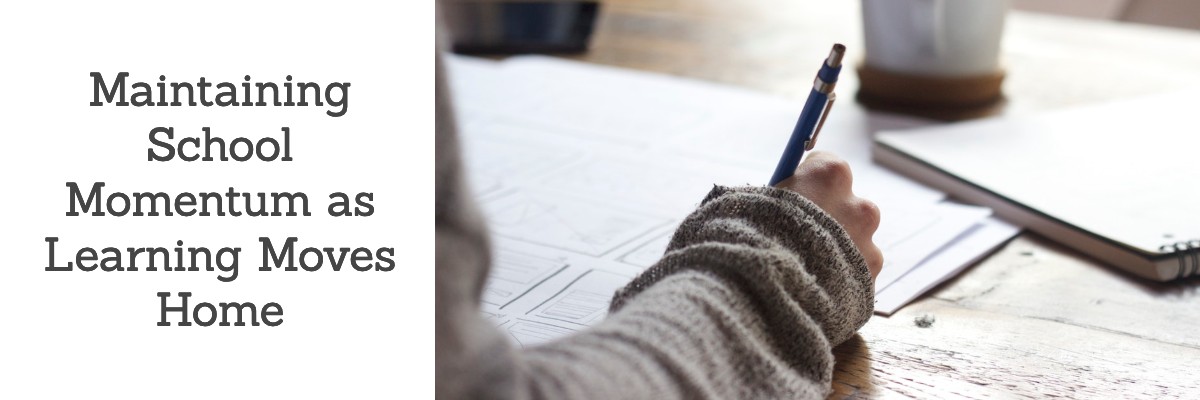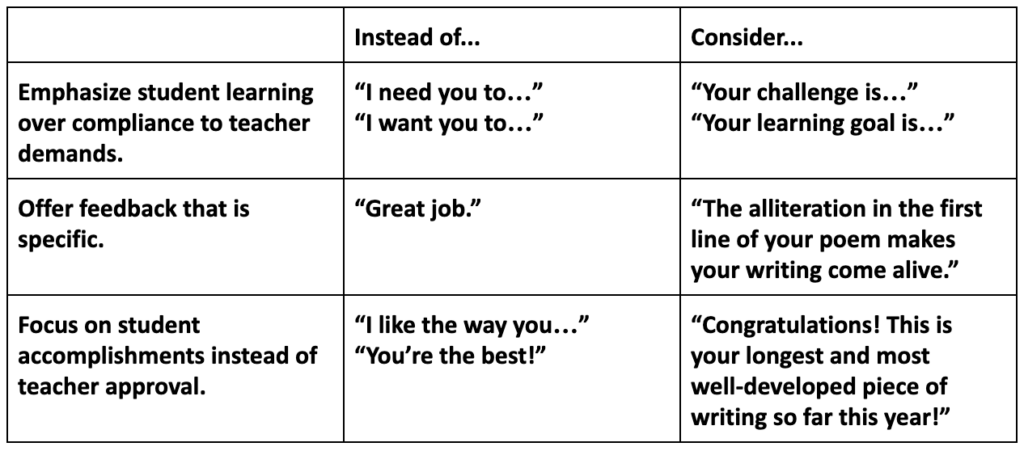Maintaining School Momentum as Learning Moves Home

You’ve spent the whole year building a community of learners. You’ve established rules and routines to help learners manage themselves and work well with each other. Now, with schoolwork potentially moving offsite, you still want to support your students as best you can. How can you help them transfer some of what’s been working in the classroom as they transition to at-home learning? The following are a few ideas to use as a starting point.
This article is part of a co-created endeavor from a group of friends and colleagues who want to stay true to our own personalized mindset by co-creating and problem-solving ways to navigate the unexpected move to an online learning ecosystem. For more posts in this series, see the links at the end of this article.
Applying Classroom Rules/Norms to At-Home Learning

You likely already have rules established in your classroom. If they are broad and global (be respectful, treat others the way they want to be treated, take responsibility for your learning, etc.), consider how these rules can help guide students as they work remotely. How might these support students as they communicate with each other? How might they help students feel a sense of ownership for their work? Consider including reminders for students about rules. For example, if you set students up as writing buddies, you might remind them of the class rule about respect: “Remember to keep giving each other respectful feedback–sharing strengths and offering suggestions for improvements.”
Teach Routines of Independent Work and Self-Management
One of the greatest challenges students may face is a release from the strict schedule of a school day. For students used to having every minute of their day managed and structured by someone else, they may struggle with the newfound freedom of at-home learning. Here are some independent work routines you might share with students. If you can, have a class meeting before school closes. Share some of these ideas with students, and have them discuss which ones might work for them. They might also suggest other ideas for each other to try. If you don’t have a chance to talk ahead of time, you could share these via an online document or through email or traditional mail.
- Work early in the day. Though we all might have different times of day when we feel most productive, as a general rule, the earlier you work in the day the better. Most writers especially have morning writing routines.
- Give yourself frequent breaks. It can feel overwhelming to try and sit down and work for a long stretch of time. Instead, try a schedule where you work for 40 minutes and then take a 20 minute break. These breaks re-energize the brain and help improve focus and productivity.
- Focus on work-time instead of task-completion. Sitting down to work on a huge research project can feel overwhelming–leading to procrastination and even paralysis. Instead, schedule time to work without the pressure of finishing a big project. For example, if you’re working on a large piece of writing, make a commitment to work for 30 minutes. Freeing yourself from task-completion stress can actually lead to a more relaxed mindset and more productivity.
- Designate a “work space” away from household hubbub. If possible, find a space to do academic work that’s as distraction-free as possible. Work will be more focused and efficient if people aren’t talking to you and a TV isn’t blaring nearby.
- Manage devices to maximize productivity. Quiet music playing through your phone might help you screen out distractions and focus on work, but if you’re going to be tempted to frequently surf for a good next song, music might be more distracting than helpful. If texts or notifications are going to scatter your concentration, try putting your devices on airplane mode during work times. Check and respond to messages during break times.
Offer Meaningful and Manageable Choices
Tap into students’ needs for autonomy, purpose, mastery, curiosity, and fun by giving choices of academic work. Try giving a few ways they might practice a math skill (an online game, a simple practice sheet, or creating their own problems to solve). Consider offering several options for independent research projects–and support them as they look for readable and appropriate resources. Give them a few ideas for ways to share what they’ve learned. Be careful not to offer choices that are too wide open–too much choice can lead students to feel overwhelmed which can actually demotivate.
Use Student-Centered Language
If at-home work feels like an exercise in teacher-pleasing or compliance, students will struggle with self-motivation. As you communicate with students, whether it’s via email, Skype, phone calls, or mail, make sure your language emphasizes their learning (instead of your requirements). As you offer feedback, focus on specific aspects of their work instead of offering bland praise or criticism. See the chart below for a few suggestions.
Continue to Build Personal Connections
Relationship-building doesn’t need to stop just because a school closes down for a while. In fact, you may even find a bit more time for personal connections with students without the daily chaos of classroom life. As you communicate with students, ask them about what else (other than academic work) they’ve been up to while home. Have they watched any good movies? Read any good books for fun? Played any good video games? Facetimed with a grandparent? Make sure to share a bit about what you’ve been doing as well. For example, in a short letter to students, you might share that you’ve finally had a chance to watch The Mandolorian or that you’ve been taking extra long walks with your dog. These small moments of connection will help you and your students continue to build rapport and relationships even while you’re not having daily face-to-face time.
None of us really knows how long or impactful the disruptions to “normal” learning may be in the coming weeks or even months. Help ease students’ worries and keep meaningful learning going by building off of all of the great routines and community building you’ve been working at all year. When you all (finally!) get to return to school, you’ll be ready to hit the ground running!
Check out these other great posts to help you support at-home learning for your students:
Mike Fisher shares a treasure trove of resources and ideas for how to leverage networks and resources.
Allison Zmuda and Bena Kallick explore ways to learn about yourself as you shift to home-based learning.
Silvia Tolisano helps reframe this time of crisis as an opportunity to dive into the possibilities and potentials of remote learning.
Aaron Roberts offers support for families as they transition to at-home learning.





